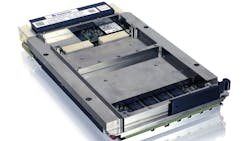SOSA open-systems standard gains momentum for embedded computing; snapshot 3 by April, 1.0 later this year
ATLANTA – One of the most influential open-systems standards to hit the aerospace and defense electronics market is expected to take hold as early as this year.
The Sensor Open Systems Architecture (SOSA) standard will evolve this year in one or two pre-releases called snapshots, and then SOSA 1.0 should roll out later this year. It couldn't happen soon enough, says SOSA expert Mark Littlefield, defense vertical product manager at Kontron America in San Diego.
SOSA seeks to drive down the cost and complexity of aerospace and defense electronics components and systems by adopting and then enforcing the use of widely accepted open-systems standards to promote component interoperability; rapid technology insertion and upgrades; reuse; and critical mass in the supplier market.
Previous attempts to do this in government and industry have produced sometimes lackluster results because of easy waivers from U.S. Department of Defense (DOD) mandates or support only from government or industry -- but not both.
With SOSA it's different. It has support from the U.S. Army, Navy, and Air Force, as well as from a broad range of embedded computing suppliers in industry; Thirteen-plus embedded computing companies now support SOSA, Littlefield says, characterizing SOSA as "a rock rolling down a hill, and cannot be rolled back." Littlefield made his comments last week at the Embedded Tech Trends 2020 conference in Atlanta.
SOSA seeks to take the best of several influential industry standards, such as OpenVPX; the Tri-Service Memo mentions the Future Airborne Capability Environment (FACE); Hardware Open Systems Technologies (HOST); Vehicular Integration for C4ISR/EW Interoperability (VICTORY); Open Mission Systems/Universal Command and Control Interface (OMS/UCI); Command, Control, Communications, Computers, Intelligence, surveillance and Reconnaissance (C4ISR) / Electronic Warfare (EW) Modular Open Suite of Standards (CMOSS); and Modular Open RF Architecture (MORA).
The idea is to form industry consensus on standards that already have momentum in the embedded systems market, as well as to adopt the core of other standards into SOSA. That way it's not a far leap for systems designers that meet the guidelines of FACE, VICTORY, OMS/UCI, CMOSS, or MORA to conform to SOSA.
Related: Open-systems standards like SOSA could promote genuine embedded computing interoperability
Moreover, SOSA seeks to narrow down OpenVPX standards to a manageable level that is appealing to the Pentagon. For example, SOSA reduces OpenVPX slot profiles from 37 to three; 3U switch profiles from 24 to three; and 6U slot profiles from 19 to three, Littlefield points out.
SOSA also seeks to settle on 12-volt power to make it less likely that systems designers will need custom-designed power conditioning and control, as well as offer certified solutions for software packages such as security and system management.
With SOSA, "security will not simply be an add-on," Littlefield told Embedded Tech Trends attendees.
About the Author
John Keller
Editor-in-Chief
John Keller is the Editor-in-Chief, Military & Aerospace Electronics Magazine--provides extensive coverage and analysis of enabling electronics and optoelectronic technologies in military, space and commercial aviation applications. John has been a member of the Military & Aerospace Electronics staff since 1989 and chief editor since 1995.
